

The Dream Issue Issue
7
No.
Spring 2023
Table of Contents Our Team & Letter from the Editor Camp Flair Hot Trends to Try Now! Let Them Eat Cake! As Seen on TV Mall Makeover 4 6 12 14 22 24 ] ]
in the Latin Community Dream Summer Song Suggestions Retro Surf Can We Separate the Art from the Artist? Glad Rags Positive Masculinity 28 31 39 40 46 50 56 Enjoy!
Mental Health
writers
Marilyn BolderMan
Sophia Reese
Leah Long
dinadja davis
Rian LounSbury
Laura Isabel
anna WilLiamS
Brooke ZarZycki
grace BaeurLe
SamMie MulLer
Taylor PucketT
Sara BerRy
designers

Max Stafford
Liz CarRolL
Rian LounSbury
jaelin hilLiard
Lexie huck
grace BaeurLe
Taylor PucketT
Sara BerRy
photographers
Max Stafford
abigaIl Schindler
Lexie huck
Taylor PucketT
Lauryl MeIle
jaelin hilLiard
models
Taylor PucketT
kelSey Lian
CharLee efaw
Maria graham
felicia RogerS
Catie jacobSon
ReIgn Parker
jimMy WilLis IiI
erika gonZalez
Leah Coale
Trey glover
audRey Irving
Max Stafford
Madison Wynns
Irene jade LaMar
jaelin hilLiard
neke Turko
Cameron hegarTy
BrayleIgh jones
Brooke ZarZycki
Talula dechev
dinadja davis
john dinkinS
kylie owen
4 | Flair Magazine
Our
Letter From The Editor


With tears in my eyes and my heart overflowing with gratitude, I am overjoyed to introduce Issue No. 7, the Dream issue. Four years ago, my 18-year-old self sat in a classroom in Bear Hall at the first ever interest meeting for Flair, blissfully unaware of what’s to come. There are few words to accurately describe the way I feel writing my last letter as Editor-in-Chief, publishing my last issue, and saying goodbye to this incredible community of creatives. Though I have gained so much creative experience and grown tremendously as an artist throughout this journey, it is genuinely the friends I have made along the way that I will cherish the most. Flair showed me that art is a community; it taught me to lean on, to help, to listen to, to encourage, and to love others. Thank you to all of the board for your continuous dedication and understanding. Thank you to both of our committees for the love and hardwork you have poured into this publication. I want to personally thank our wonderful Associate Editor, Marilyn Bolderman, for always grounding me and showing me new perspectives; our Director of Fundraising & Marketing, Sara Berry, for connecting Flair to our community in ways we’d only ever dreamed of; and to our Director of Art & Design, Rian Lounsbury, my creative rock and unconditional support system through it all. If you have contributed to or supported this magazine in any way, from the bottom of my heart, thank you.
As all of the board graduated from UNCW this year and will be closing our chapters with this incredible magazine, it only felt right to call this issue, “Dream.” As children we were asked what we dreamt of being when we were older—I wanted to be a teacher. In high school, I dreamed of moving far away from home and never turning back. I didn’t dream of going to college. I, hilariously, dreamed of being a famous YouTuber. The theme of this issue is meant to remind us all that our dreams are allowed to change alongside our life paths and our persons. At 22-years-old I dream of moving back home to be closer to my family. I graduated from college this month and I definitely don’t want to become a famous YouTuber. The question, “What’s your plan?” is truly rhetorical. We are expected to have an answer, yet the reality is that life hardly ever follows an organized plan step-bystep. As you read this issue, I encourage you to have an open mind and an open heart to the inconsistency of life. I hope that you find new dreams, hold onto or let go of old ones, and never give up on the ones that feel right in the moment.
It is with the utmost respect and love that I am able to pass the position of Editor-in-Chief to such a dedicated, talented, and supportive member, Max Stafford. It is inevitable that this publication and this community will continue to grow and change alongside Max and the new board. Times are genuinely bittersweet but I am eager to see what the future holds for Flair and I am overly confident in our new board. Good luck to you all <3 Dream on!
| 5
Love, Taylor Puckett Flair Magazine

6 | Flair Magazine
CAMP FLAIR CAMP FLAIR

Photographer: Max Stafford
Creative Director and Designed by: Max Stafford
Models: Taylor Puckett, Rian Lounsbury, Marilyn Bolderman, Sara Berry, Brooke Zarzycki, Anna Williams, Baylee Smeeton
Styling: Max Stafford
Lighting Assist: Lauryl Meile
Props: Max Stafford, Taylor Puckett, Rian Lounsbury, Marilyn Bolderman, Baylee Smeeton
Flair Magazine | 7
*NOT PICTURED* BENNETT HAIR CULTURE EDITOR
*NOT PICTURED* BENNETT HAIR CULTURE EDITOR
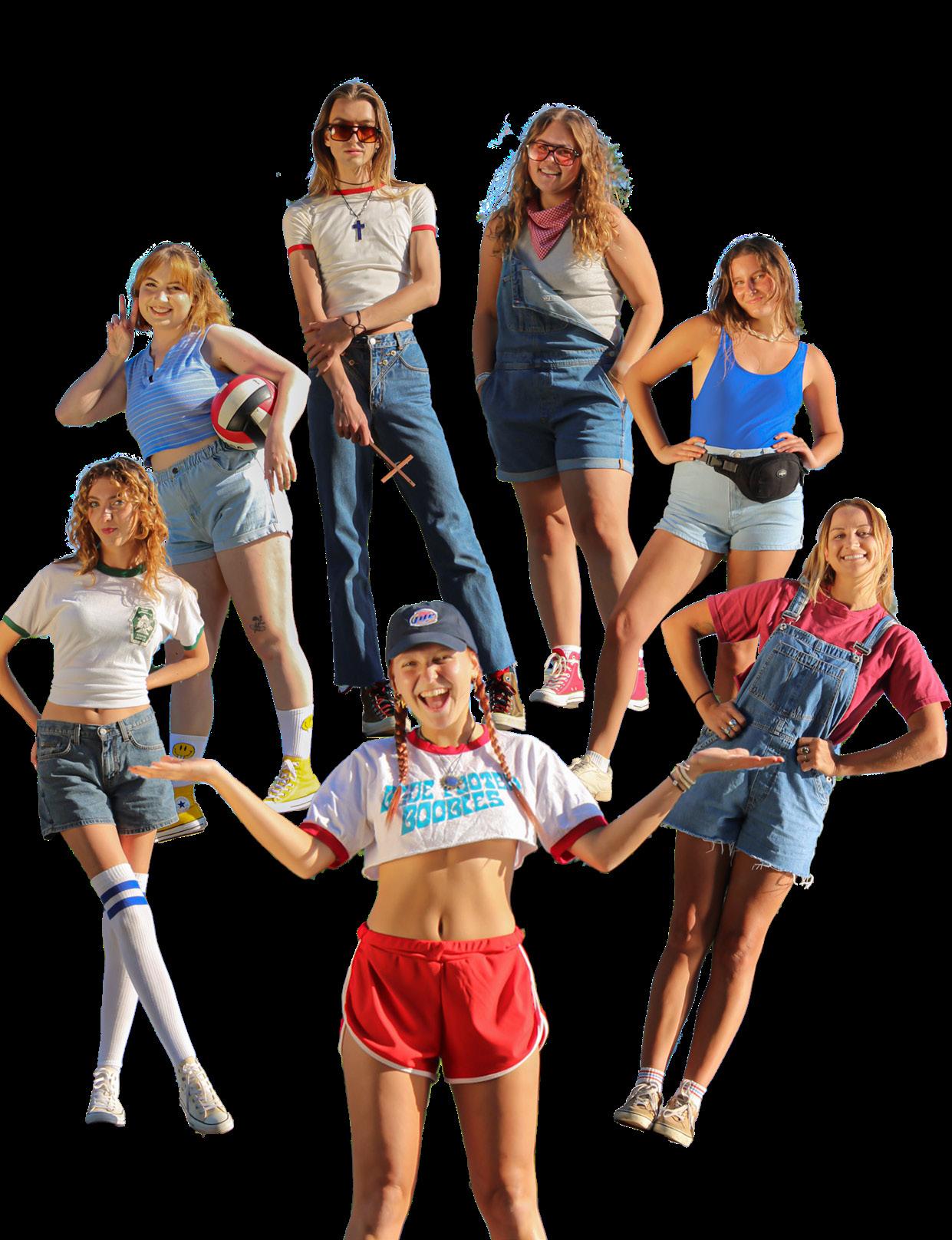
 Sara Berry Director of Fundraising and Marketing
Baylee Smeeton Social Media Chair
Rian Lounsbury Director of Art and Design
Marilyn Bolderman Associate Editor
Anna Williams
Fashion and Beauty Editor Brooke Zarzycki Lifestyle Editor
Taylor Puckett Editor in Chief
Anna Williams
Fashion and Beauty Editor
Marilyn Bolderman Associate Editor
Brooke Zarzycki Lifestyle Editor
Rian Lounsbury Director of Art and Design
Baylee Smeeton
Social Media Chair
Sara Berry Director of Fundraising and Marketing
Taylor Puckett Editor in Chief
Sara Berry Director of Fundraising and Marketing
Baylee Smeeton Social Media Chair
Rian Lounsbury Director of Art and Design
Marilyn Bolderman Associate Editor
Anna Williams
Fashion and Beauty Editor Brooke Zarzycki Lifestyle Editor
Taylor Puckett Editor in Chief
Anna Williams
Fashion and Beauty Editor
Marilyn Bolderman Associate Editor
Brooke Zarzycki Lifestyle Editor
Rian Lounsbury Director of Art and Design
Baylee Smeeton
Social Media Chair
Sara Berry Director of Fundraising and Marketing
Taylor Puckett Editor in Chief
8 | Flair Magazine





Flair Magazine | 9

10 | Flair Magazine


Flair Magazine | 11
Hot Trends to Try Now!

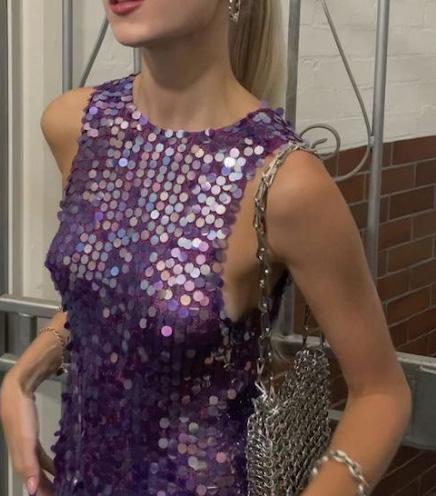 Written by Sophia Reese
Designed by Rian Lounsbury
Written by Sophia Reese
Designed by Rian Lounsbury
Belts:


Belts are better than ever right now and the fashion world is welcoming them by saying, “The more, the merrier!” Sometimes one belt simply isn’t enough and it may take playing around with stacking or criss-crossing them on top of one another to create that perfect statement accessory. Belts are no longer just a practicality; they are meant to stand out. Adding a belt (or two) to your outfit does exactly that. The options are limitless! For a more everyday look, try sliding one of your favorite patterned or bold buckled belts through your jeans and call it a day–a wellstyled day that is. If you wanna dress up a bit more, letting a belt lay at the hips over a dress or skirt can be excellent for adding a classy or edgy touch. When it comes to double belts, don’t let it overwhelm you, and try to find belts that are similar in size or complement one another in color. This allows them to still make a statement without interfering with the unity of the fit.
Mermaid Core:
When I first heard metallic was becoming a trend I was not obsessed with what I was seeing. Then I hopped on over to Pinterest and was reminded that I actually do like metallic; more so when it is a smaller piece of the puzzle. Bangles, earrings, pendants, belts; they all brought me back to the vision of a coastal, yet punky mermaid. And who doesn’t love the best of both worlds? However, it’s not just metallic we are talking about. Sequin is here. But I am not talking about the sequin we wore in all of our Justice outfits growing up. I’m talking about an elegant sequin, a subtle and sheer sequin. Particularly sequin maxi skirts and dresses. They can be worn casually with a t-shirt and sandals as you stroll through town on a hot summer day. You can also go glam and partner the maxi with a pair of kitten heels or heeled boots for a night out. A key to mermaid core is also the color palette, so try looking for soft hues of blues, purples, greens, pinks, and beige to help your self tap into the mermaid mindset. Once the clothes are picked out, add on your metallic accessories such as bangles and rings. Try out a glossy makeup look, and for a finishing touch see if there is anywhere else you can incorporate your own little bit of shimmer! The world is your OYSTER!

12 | Flair Magazine
Adidas Originals:
The 3 stripe life is real and waiting to be embraced. Whether it is Adidas forums, sambas, gazelles or the new Campus 00s, this shoe brand goes above and beyond when creating the perfect versatile everyday sneaker. One of the best perks to the Adidas Originals styles is the range of fun colors they come in, allowing wearers to choose how subtle or bold they want to make their outfits. There is no right way to style these shoes because they can truly be worn with just about anything!
Styling tip #1: Wearing them with a simple pair of low-cut to mid-calf socks will be useful in tying the shoes into the whole look so they do not appear isolated.
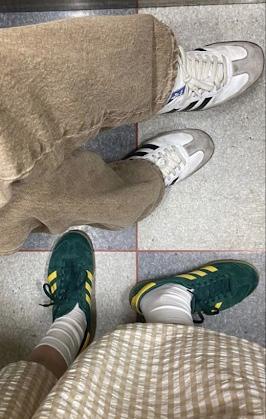

Styling tip #2: Try focusing on the colors or textures in the shoes and look for ways to incorporate those same aspects into the accessories or other pieces of clothing you are wearing.
Maxi Skirts:
I don’t see there ever being a time in my life when I don’t love a good maxi/midi skirt moment. They can be dressed up or down so easily, and are the perfect way to keep things fashionable during all seasons. From denim to cargo to plaid, there is such a range of material that these skirts come in, and frankly, I don’t think you can go wrong with whatever you choose.
Keep it casual: Denim maxi skirt + graphic tee/tank + sneakers + denim jacket + sunnies + favorite jewelry

Dress it up: Maxi skirt + Going out top + heeled boots + statement belt + favorite jewelry


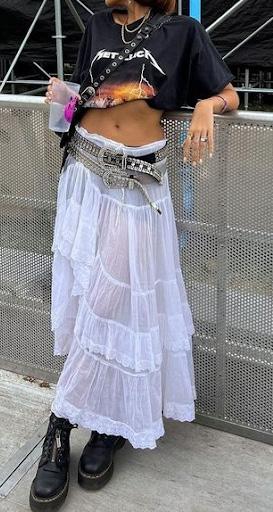
Flair Magazine | 13
Let Them Eat Cake
Let Them Eat Cake
Photographer: Abigail Schindler
Creative Director: Jaelin Hilliard
Models: Taylor Puckett, Kelsey Lian, Charlee Efaw

Makeup: Grayson Vick
Hair: Lauryl Meile, Madison Wynns
Styling: Madison Wynns, Leah Coale, Cecilia Moushey, Rian Lounsbury, Jaelin Hilliard
Lighting Assist: Max Stafford, Lauryl Meile
Props: Jaelin Hilliard, Max Stafford, Madison Wynns
Designer: Jaelin Hilliard
14 | Flair Magazine



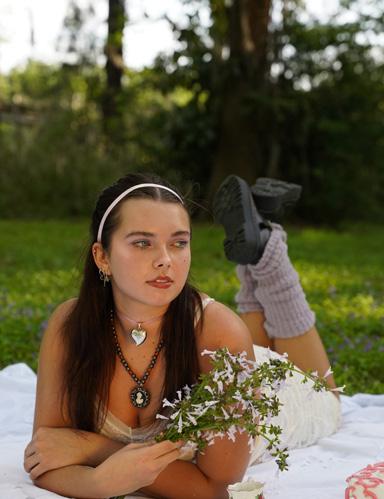
Flair Magazine | 15





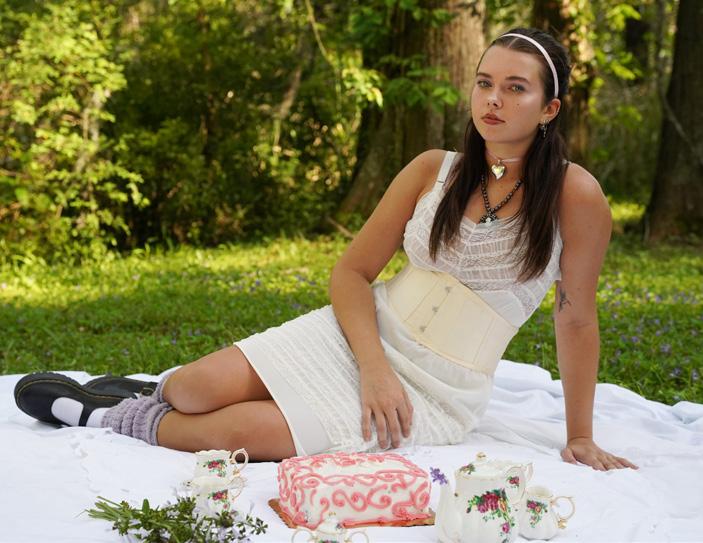

16 | Flair Magazine


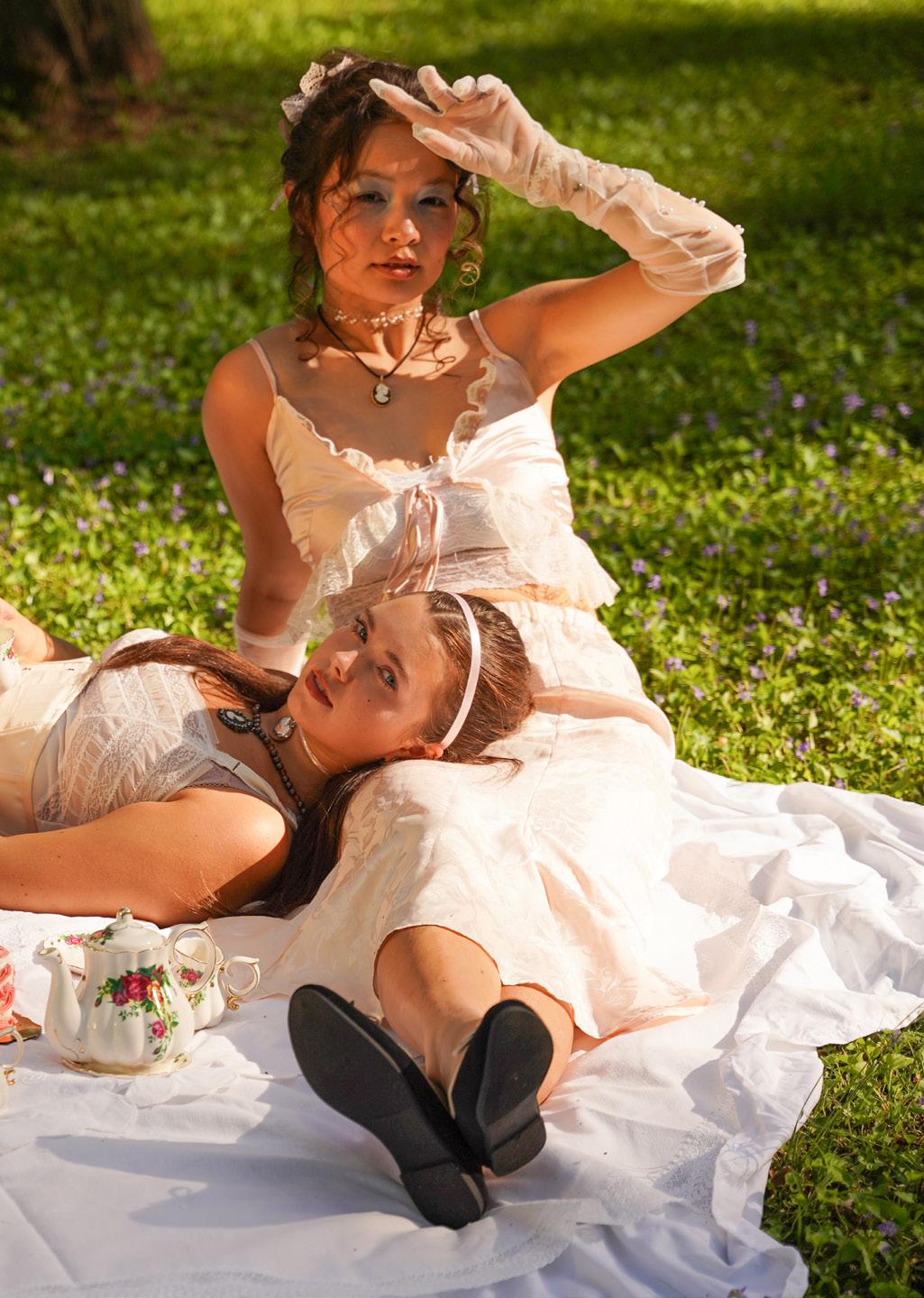


Flair Magazine | 17






18 | Flair Magazine
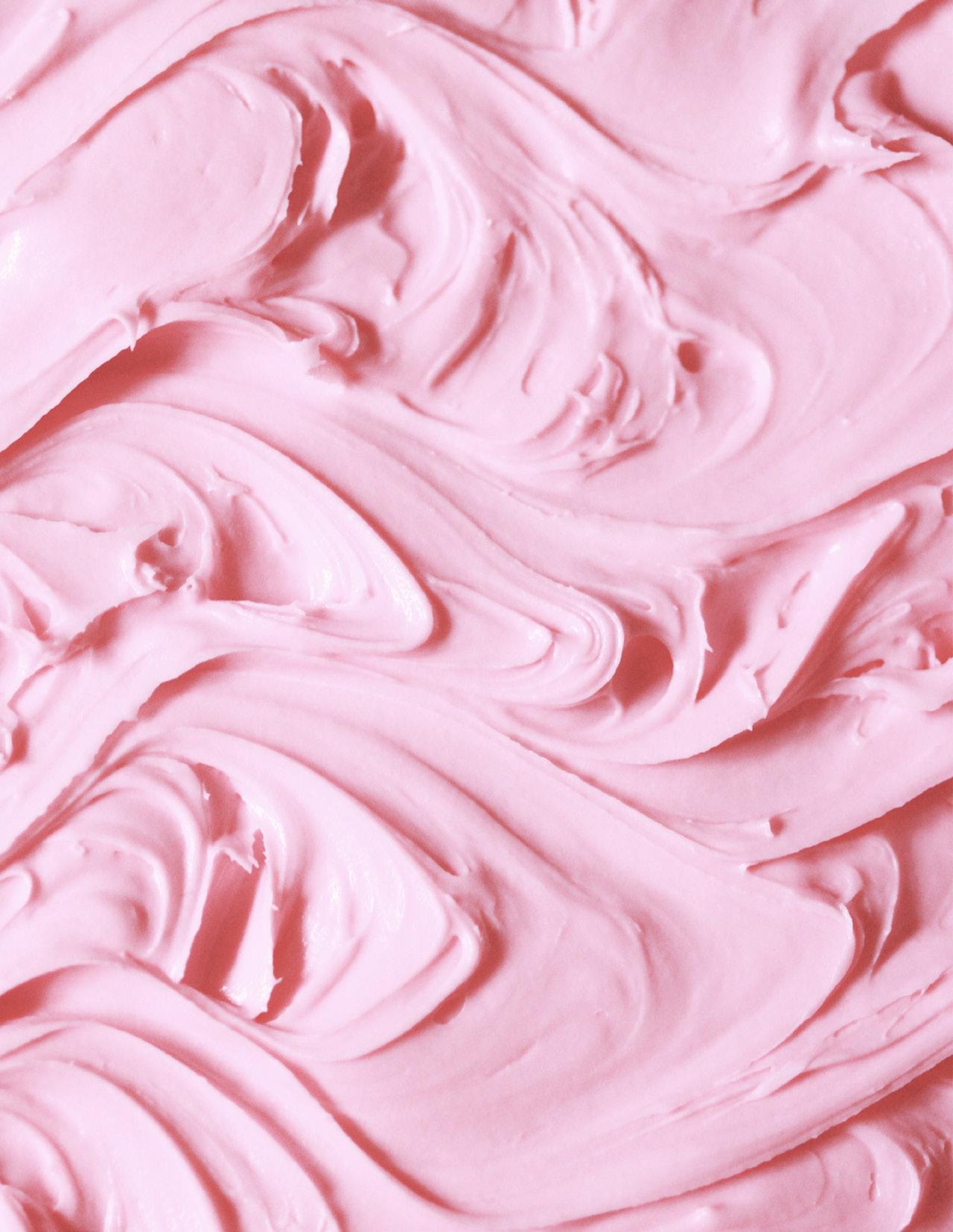


Flair Magazine | 19
Written by Leah Long
Designed by Jaelin Hilliard

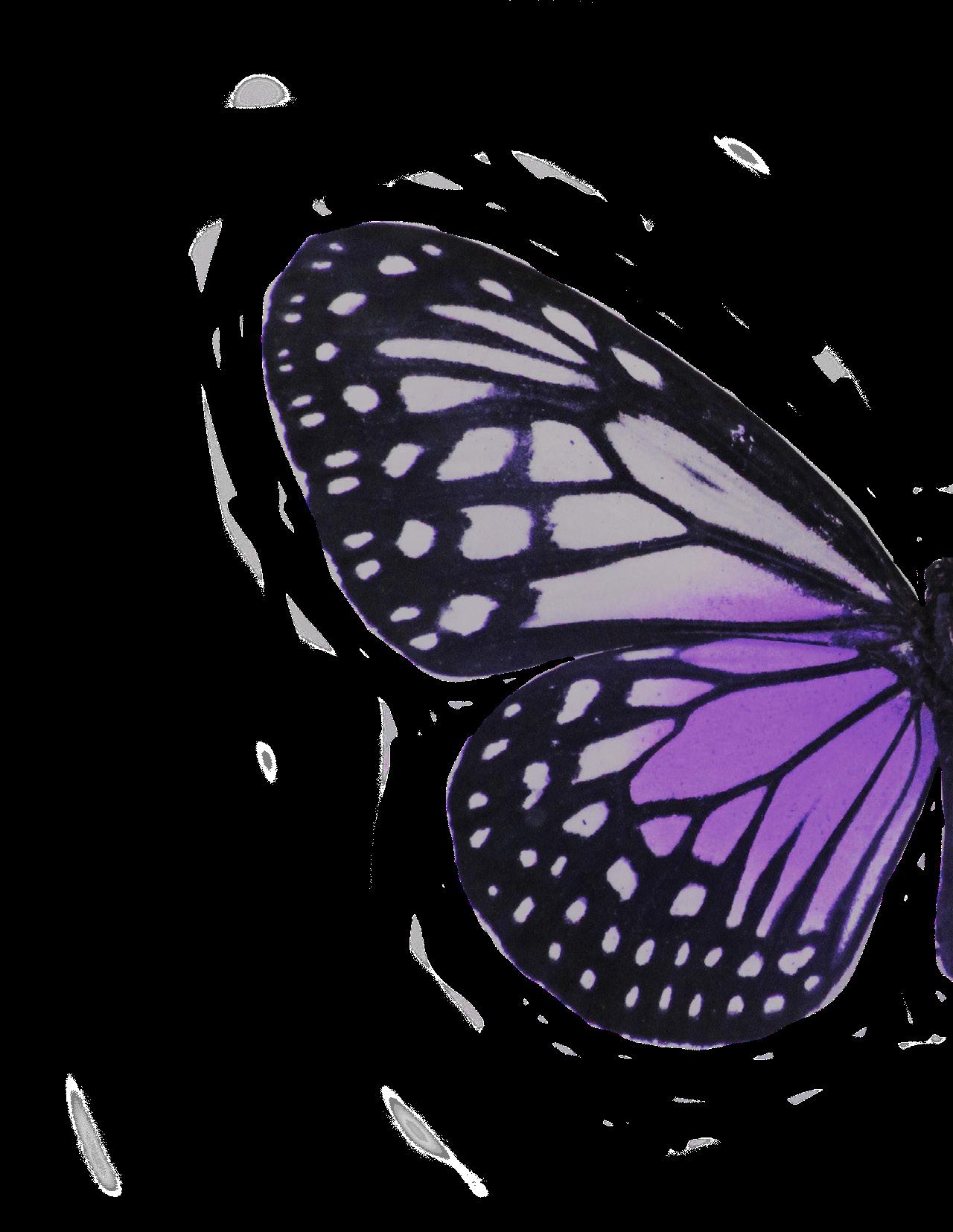
Femininity Fatale
Pink was my first favorite color. My walls, bedsheets, clothes, and toys were all pink. Ariel was my favorite princess, I wanted to learn ballet, I loved the Barbie Rapunzel movie, and I only got along with girls. Granted, some of this was due to the expectations set on me simply because I was born a girl, but as I navigated my way through elementary school, I spent a lot of time exploring different hobbies and interests. My mother always supported whatever I chose to do, so my interests changed. I followed the standards of what my classmates told me was cool, which was really just what everyone told them. All of the things that had made me feel beautiful were now a sign of being a weak, dumb, annoying, girl. I had my walls repainted, I joined a soccer team, the hot new status of my favorite color was blue, and I rejected all things “girly.” I began to befriend the girls that were more like me, and drifted away from the girls who kept their feminine interests. Being a tomboy was all the rage and felt like the only way to be accepted. Every basic stereotype against women you could think of was running rampant, at least throughout my small town elementary school. I was definitely more accepted this way, yet, despite my conformity, I still didn’t feel like I belonged in the space I took up in the world. Everyone, including myself, was so quick to sort others into groups and throw around labels. I felt they didn’t understand me and I didn’t understand them, and this feeling followed me until high school. As I got older and began actively trying to find myself, I found my unique, intelligent, open minded friends— all women who were very different, yet so similar, to myself. I walked through high school effortlessly. I had many struggles and hard days, as everyone does, but it felt easy when I always had the unconditional love and support of my favorite women to turn to. I felt like I belonged with them. I felt understood and cared for, and I made sure they felt the same love from me. It was something about being surrounded by my friends who were struggling, growing, and discovering how their own worlds would flow that allowed me to embrace all of the traditionally feminine things that I had rejected for years. I also welcomed my emotions, which I had never done, and I just bloomed. My mindset shifted away from “the world is against me” and towards an understanding that the world has so much to offer with the people on it as the most special part. I rejected my judgements towards other women. I paid attention to the impression I made on others, trying to become someone that they could feel comfortable and welcomed around. This made me feel more comfortable and welcomed too.
masculinity are not simple, and have a clear and close relationship people treat each other. Young girls being taught to hate their attraction to femininity at a young age teaches them to hate the comfort that other girls have with their own. It creates jealousy, division, and eventually it creates the girl that you see at parties pointing and laughing at other girls.
Internalized sexism is one of those horrible patriarchal society induced phenomena that takes time to unlearn. In the Harvard Business Review, Mikaela Kiner writes, “women unconsciously absorb beliefs about their rightful place, and those messages show up in how women judge each other.” Women are often made to feel as though they are competing with each other, when every woman should feel as though they have room to shine and sparkle in whatever way they feel the most fulfilled.
While every woman possesses unique feelings and experiences, we’ve all been both judgemental and judged. Women tend to be judged by the world for anything; you’re either trying too hard or look too basic, you’re either too loud or too quiet. Every word you say can be scrutinized simply because you are a woman saying it. In a study done by Doré Butler and Florence Geis, it was found that female leaders elicited more negative responses than male leaders from all participants, regardless of gender. It doesn’t help that women are constantly pitted against each other and made to feel as though there will never be enough room for all of us. This feeling that there can only be one creates a scarcity mindset among women, in turn creating the feeling that we have to fight for acceptance and that there isn’t enough room for all of us.
With all of this being said, it’s important for us to see this judgment within ourselves and work to reverse it. The fault does not lie on women, but on those who uphold this system and its stereotypes. The way a woman presents herself should be fully dependent on how she feels most comfortable. While my own struggle was with embracing femininity, each person’s experience is unique. There are women who feel most comfortable with femininity, some with masculinity, and some who prefer none of it or everything in between. All women should be able to explore whatever they please, free from judgment, especially from each other. Be the woman that allows other women to feel comfortable.
American Psychological Association. (n.d.). Apa PsycNet. American Psychological Association. https:// psycnet.apa.org/record/1990-14605-001


It’s time to break the cycle of female rivalry. Harvard Business Review. (2021, October 11). https://hbr. org/2020/04/its-time-to-break-the-cycle-of-female-rivalry Flair Magazine | 21

As seen on TV
Written by: Dinadja Davis
As a person who was practically raised by TV, it has impacted me in many ways. From preppy and feminine fashion inspired by movies like Legally Blonde and Clueless, to the whimsy gothic inspiration of films like Practical Magic and The Craft. There are many ways in my life where film and television have shaped me, having its biggest impact on how I present myself to the world through fashion. I interviewed UNCW students to find out how film and television has impacted their personal style.

1. What is your name, and a little about yourself
a. If you could describe yourself to someone you don’t know how would you?
2. If you had to describe your personal style of fashion in three words what would they be? And why?
3. What does your personal style say about how you are as a person?
a. How do you want to come off to the world?
4. When you were younger what was a film or tv show that resonated with you in a way of impacting your personal style? And how?


5. In what way did this tv show/film help you shape your current style, and in what ways is your personal style similar or different to the elements of the film/tv show?
John Dinkins, International studies major at UNCW

Three words that describe his personal style: versatile, eye-catching, and suave.
“I think what my personal style says about me is that I’m not afraid to venture out in different styles. Everyone should have some freedom on how they want to dress themselves regardless of others’ opinions.” “I want to come off to the world as down to earth and most importantly kind! But also add some flair to it with my personality and outfits.” “The TV show currently that is swaying my direction of fashion would be this Japanese anime called “Nana”. The main character, Nana, has an edgy, grunge-like and punk kind of fashion style which is what I’m trying to get into at the moment. Nana is currently shaping my current style through the use of darker outfits, usually being an all black outfit. That used to never be my style but I’m currently using my freedom in fashion to experiment and not only do colorful and preppy clothes, but also darker styles of fashion as well!”
22 | Flair Magazine
Designed by: Liz Carroll
Bella Dalessio-Skare, Clinical research major and neuroscience minor at UNCW
Three words that describe her personal style: Feminine, monochrome, coquette.
“I really like feeling and presenting very feminine, that’s definitely where I feel most comfortable and confident. I really want to come off as someone who is confident and sure of themselves with the way that I dress. I also want people to have the perception that I’m someone who also appreciates art or the finer details of things because I do like to put in a lot of effort into the way I dress depending on the day or occasion.” “The only tv shows that are coming to mind currently are the shows Buffy the Vampire Slayer and Nana which is an anime. I really liked Buffy’s signature boots, so much so that I had to buy a similar pair for myself. I also really liked how in that show they utilized longer black leather jackets and cross jewelry. From Nana, I really picked more up on accessorizing and appreciating the whole Vivienne Westwood aesthetic that is pivotal in the show. This brought me more into the delicate more feminine style that Vivienne Westwood is known for.”



Erika Gonzalez, Marketing major at UNCW
Three words that describe her personal style: spunky, retro, and innovative.
“The 1970s and 1980s era are my favorites, and I love channeling that in my everyday life. Wearing items the “wrong way” or by giving it alterations is always a thrilling adventure. I want to come off to the world as energetic, ambitious and kind.”“A movie that influenced my style as a kid was The Breakfast Club. The classic 1980’s American teen wardrobe staples were represented, the leather jacket, the maxi skirt, denim on denim, and chunky boots. These statement pieces can elevate an outfit, but also offer a timeless charm which I enjoy.” “The characters were high school stereotypes which each respected distinct aesthetics. This sparked in me that we are all multidimensional beings, and that we do not have to stick to one aesthetic. It has shaped the way that I formulate outfits, by choosing through various pieces of different aesthetics. Playing dress up and expressing yourself through clothes is exhilarating; picking and choosing diverse pieces from each character, and making my own version of myself.”

Flair Magazine | 23

24 | Flair Magazine
Creative director: Rian Lounsbury
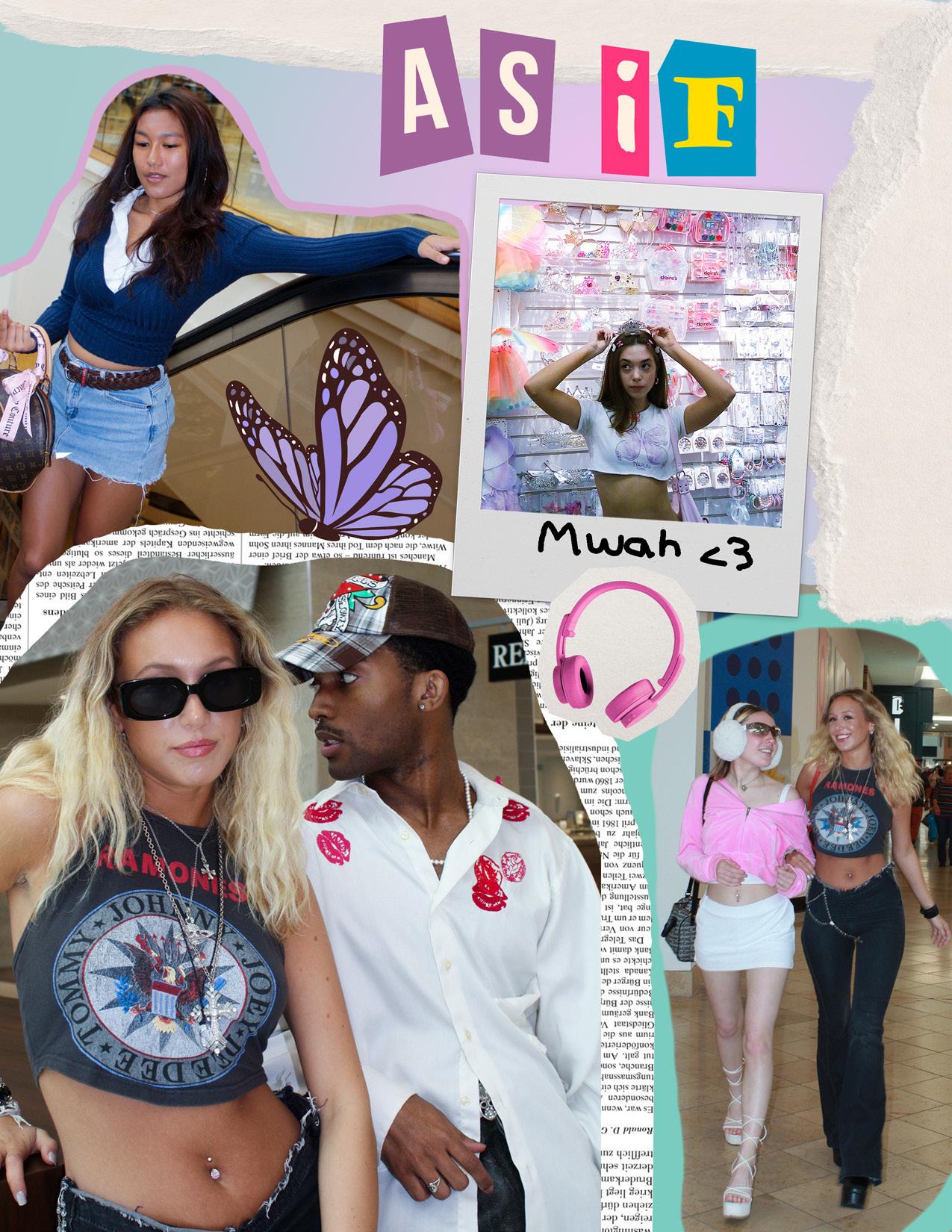
Flair Magazine | 25
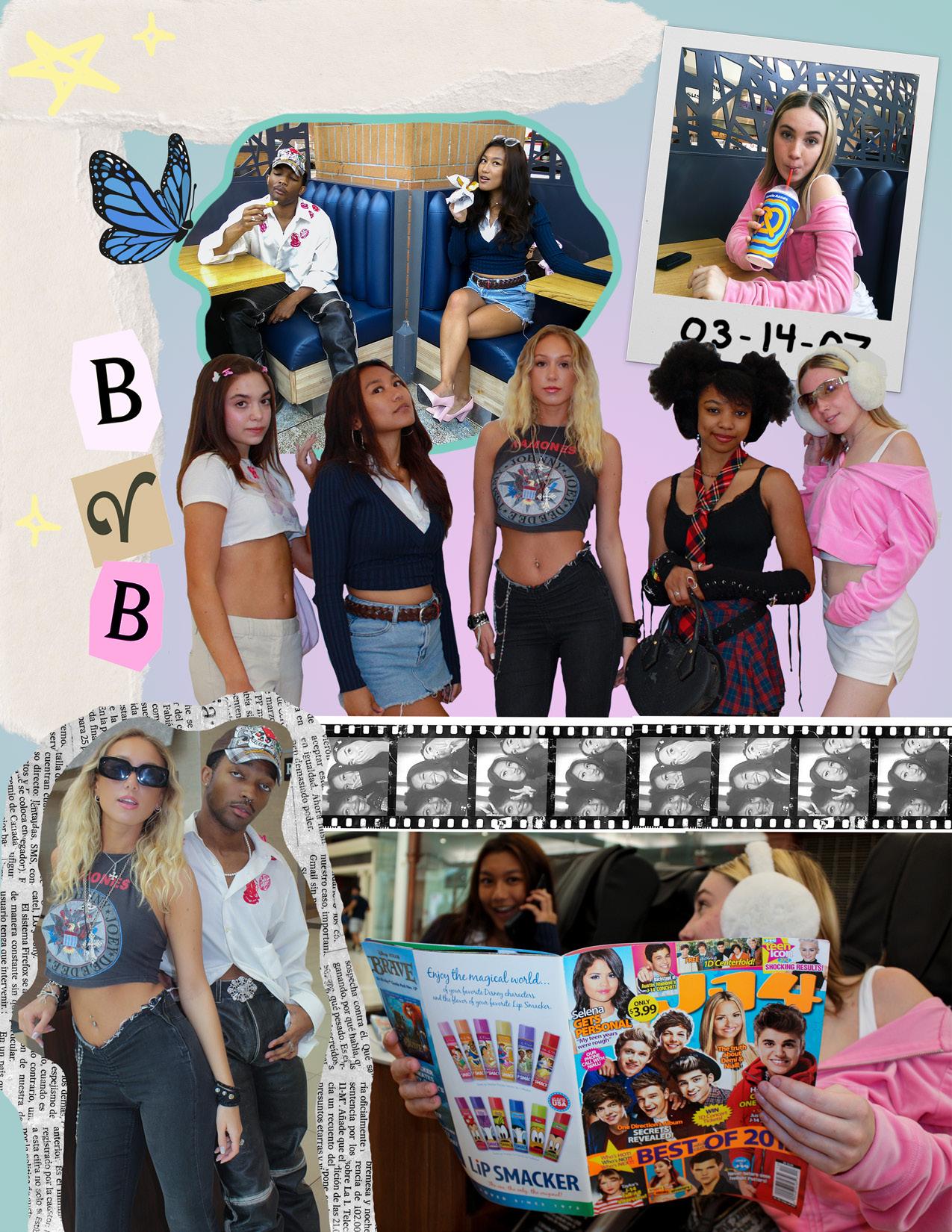
26 | Flair Magazine
Mall Makeover: Revamping 2000s
Teen Fashion Styles and the Places They Were Born
 Written By: Rian Lounsbury Designed By: Lexie Huck
Written By: Rian Lounsbury Designed By: Lexie Huck

Where once malls were a place for teens to mingle and play: trying on shoes they couldn’t afford, spraying on tester perfumes, and dining on bites of orange chicken served to them on a toothpick, we now see still-standing shopping centers implementing bans on unaccompanied youth. The mall was a place for real people to see and be seen before social media. We look back on these 2000s styles now through the lens of celebrity photos or advertising, but that is not whyat real people were wearing. The subsequent revival of late 2000s mall-core fashion styles have some degree of mistranslation when removed from the cultural context of actually going to the mall. Now designed for TikTok and Instagram, style influencers update these nostalgic looks for a new generation- I think we will always find cool what we were slightly too young to be fully part of as kids (the big sister effect). Aliyah Bah of @aliyahsinterlude1 on TikTok is known for the creation of her iconic, personal style “Aliyahcore” which through DIY and unique styling of modern and vintage pieces pays homage to late 2000s scene and EDM rave fashion. Shy Smith, as @shysmith on TikTok, took a very nostalgic approach, gaining fame through faithful recreations of early 2000s movie scenes or celebrity paparazzi videos. Now Shy has started to progress her style through the decade, showcasing more late 2000s preppy looks with cardigans and long camisoles like what was seen at Abercrombie & Fitch at the time.
During the pandemic, shopping became divorced from leisure, returning to its primal nature of the acquisition of needed goods for a homestead under threat. Going out for a “shopping trip” became a danger, and in the subsequent economic recession, an irresponsibility. Online shopping allowed for self-soothing impulse purchases, opting to gamble on the quality, or successful delivery, of an unseen good rather than gamble with one’s health. Online fast fashion retailers offer their products at an even cheaper shipped price than in-person shopping, relying on a customer finding an ambivalent satisfaction in keeping whatever low-grade garment they receive and not having to go through the process of shipping back an online return.
Remaining successful malls today are indoor-outdoor and appeal to upper middle class working professionals moreso than children, optimized and selling Lululemon athleisure next door to Soulcycle work out classes. Some less successful, “dying” malls with their subsequent lower rent costs have enabled small businesses to afford first-time storefronts to also use as warehouse locations to store and ship from to support their online businesses. Abandoned shopping malls increase in number yearly, with high costs to renovate and seemingly limited options for repurposing. The most romantic option is to transform them into mixed-use developments, that are made stable by supporting a variety of needs across sectors as residential, commercial, and recreational spaces. Another possibility is to convert them into educational institutions, like community colleges or vocational schools. Abandoned malls can be transformed into office spaces, as was the case with my childhood mall, Cary Towne Center outside of Raleigh, NC, which is being rebuilt as a corporate headquarters for Epic Games. Whatever the final use, the transformation of abandoned shopping malls requires careful planning, creativity, and collaboration.
Mental Health in the Latin Community
written by Laura Isabel designed by Rian Lounsbury
As many of us know, mental health is a topic that is gaining a lot of attention in today’s society. There are a lot of people who are unaware of how this topic has been treated in cultures and communities different from their own. Mental health and gender stereotypes are complex issues that vary across different Latin cultures; however, these are my experiences as a Latina.
In Latin cultures mental health is often stigmatized. There are many reasons why these stigmas reside in the Latin community. For example, the Latin community holds traditional catholic values, including the respective gender roles. Within these communities, men are expected to be strong, assertive, and in control, while women are expected to be nurturing, submissive, and emotional. These gender roles are deeply rooted into our history and culture; even in today’s day and age the Latin community still upholds these roles. These stigmas have a significant negative impact on mental health. However, with a negative connotation surrounding receiving help for mental health, seeking treatment is not something done often.
According to the 2020 National Survey on Drug Use and Health (NSDUH), nearly eight million Latino adults reported having a mental illness. However, even for those who sought treatment, resources were not properly allocated. Serious treatment gaps exist for Latino youth with major depressive disorder. In 2020, 57.3 percent of white youth with major depressive disorder and suicidal ideation received treatment. However, only 39.6 percent of Latino youth received treatment, creating a gap of nearly 18 percentage points.
It is often frowned upon to seek mental health services, especially for men since it is seen as a sign of weakness, a threat to their masculinity. Machismo is rooted into our culture making it extremely challenging for Latin men to seek assistance when in emotional distress. This makes it more likely for these men to turn to unhealthy coping mechanisms.
On the other hand, women may be more likely to seek help for mental health issues. Although not identical, they face a similar set of challenges. Women are expected to prioritize their family’s needs over their own. Leading to a suppression of these emotions and feelings. Latin cultures also tend to view mental health issues as a personal failing, which brings on a feeling of anxiety and depression, on top of these negative feelings.

28 | Flair Magazine
However, there is a lot of hope. There is a growing push to move away from traditional gender roles. Additionally, the younger generation is taking steps forward to break this stigma by seeking help. There is a growing awareness and acceptance of mental health issues in many households and communities. For example, there is a growing recognition of mental health issues in the Latin community in the United States. Many Latin individuals and organizations have been vocal about the need to address mental health issues and the stigma surrounding them. This has resulted in an increase in mental health resources and services, including bilingual therapists and culturally sensitive programs for culture specific issues. These resources have been implemented and adapted into many communities. For example, Mexico has implemented a national mental health strategy that aims to improve access to mental health services, reduce stigma, and promote community-based care. Similarly, Colombia has established a national mental health policy that prioritizes prevention and early intervention and provides funding for mental health services and research.
What’s more is that there is a growing Latin media and entertainment with people who can talk about their experiences. These individuals have begun to address mental health issues such as depression, anxiety, post-traumatic stress disorder, and other mental health issues not only on their social media, but also in mainstream media such as movies and tv shows.
Although mental health may be seen as this strange and difficult problem to solve, the Latin community is starting to heal. The public support, as well as the increase in better treatments available to the Latin people, things are starting to look up. Hopefully, the Latin community, as well as other cultures, will continue to grow towards a better and brighter future. Some resources available here in Wilmington include Latin American Community Center: The Latin American Community Center in Wilmington offers a range of services, including mental health counseling, support groups, and referrals to other resources in the community. They have bilingual staff members who can help you access the services you need. NAMI Wilmington: NAMI (National Alliance on Mental Illness) Wilmington is a nonprofit organization that provides mental health support and education to individuals and families affected by mental illness. They offer support groups, educational programs, and advocacy services,
and they have Spanish-speaking volunteers available to assist. Coastal Horizons Center: Coastal Horizons Center is a nonprofit organization that provides a range of mental health and substance abuse services in Wilmington and the surrounding areas. They have bilingual staff members who can assist with mental health assessments, counseling, and referrals to other resources.Trillium Health Resources: Trillium Health Resources is a managed care organization that provides mental health and substance abuse services to individuals in southeastern North Carolina, including Wilmington. They have a Spanish-speaking customer service line and can connect you with providers who offer bilingual services. Southeastern Mental Health Center: Southeastern Mental Health Center is a community mental health center that provides a range of services, including counseling, medication management, and case management. They have bilingual staff members who can assist with accessing services. Lastly, Centro Hispano is available at UNCW in Fisher. Centro Hispano is a great resource were one can connect with other Latinos as well as talk to mentors.
 Illustrated by Laura Isabel
Illustrated by Laura Isabel
FLAIR LIBRARY

The Nickel Boys by Colson Whitehead
“We must believe in our souls that we are somebody, that we are significant, that we are worthful, and we must walk the streets of life every day with this sense of dignity and this sense of somebody-ness.”
Elwood Curtis is a young man with strong moral dignity. He lives his life based on the words of Dr. Martin Luther King “we will wear you down with our capacity to suffer, and one day we will win our freedom”. He is preparing to embark on his seemingly bright future when an innocent mistake derails his life. Elwood finds himself at Nickel Academy, a place where young black men are sent to be turned into “honorable and honest men”. Elwood struggles with what he’s always believed as he faces a cruel reality. Based on the history of a reform school in Florida that destroyed the lives of thousands of children, this novel explores the issues that plague our country still today.
Welcoming the Unwelcome by Pema Chodron
“We can radiate our basic goodness from one whole body, sending it out to more and more beings–across countries, continents, and worlds–until it pervades all space”
Welcoming the Unwelcome is a book that teaches us how to exist in the present moment, no matter what feelings may surface. In a world filled with negativity, Pema Chodron shows us that open-hearted human connection is the key to true compassion. She invites us to stop resisting negative emotions and embrace them in a way that opens the heart to the raw vulnerability that
Matrix by Lauren Groff
“Nothing is all stark and clear any longer, nothing stands in opposition. Good and evil live together; dark and light. Contradictions can be true at once. The world holds a great and pulsing terror at its center. The world is ecstatic in its very deeps.”
This is the story of Marie. Condemned to live as a nun despite her own disapproval of religion, she defies the norms of the 14th century as she creates a protective utopia for her sisters. Marie is before her time as she demonstrates the power that women hold in any era and against any odds. This tale of medieval nunnery is surprisingly relevant and inspiring for the modern world.
WRITTEN BY: Anna Williams
DESIGNED BY: Grace Baeurle
30 | Flair Magazine
Creation direction: Rian Lounsbury, Taylor Puckett, Art & Design committee

Models: Erika Gonzalez, Leah Coale, Trey Glover, Audrey Irving, Max Stafford, Madison Wynns, Irene Jade LaMar, Jaelin Hilliard
Makeup: Grayson Vick, Taylor Puckett
Styling: Taylor Puckett, Rian Lounsbury, Max Stafford, Madison Wynns, Jaelin Hilliard, Irene Jade LaMar, Pomegranate Moon

Props: Liz Carroll, Pineapple Studios
What’s a dream you gave up on?
Photography & Design By: Taylor Puckett
Flair Magazine | 31
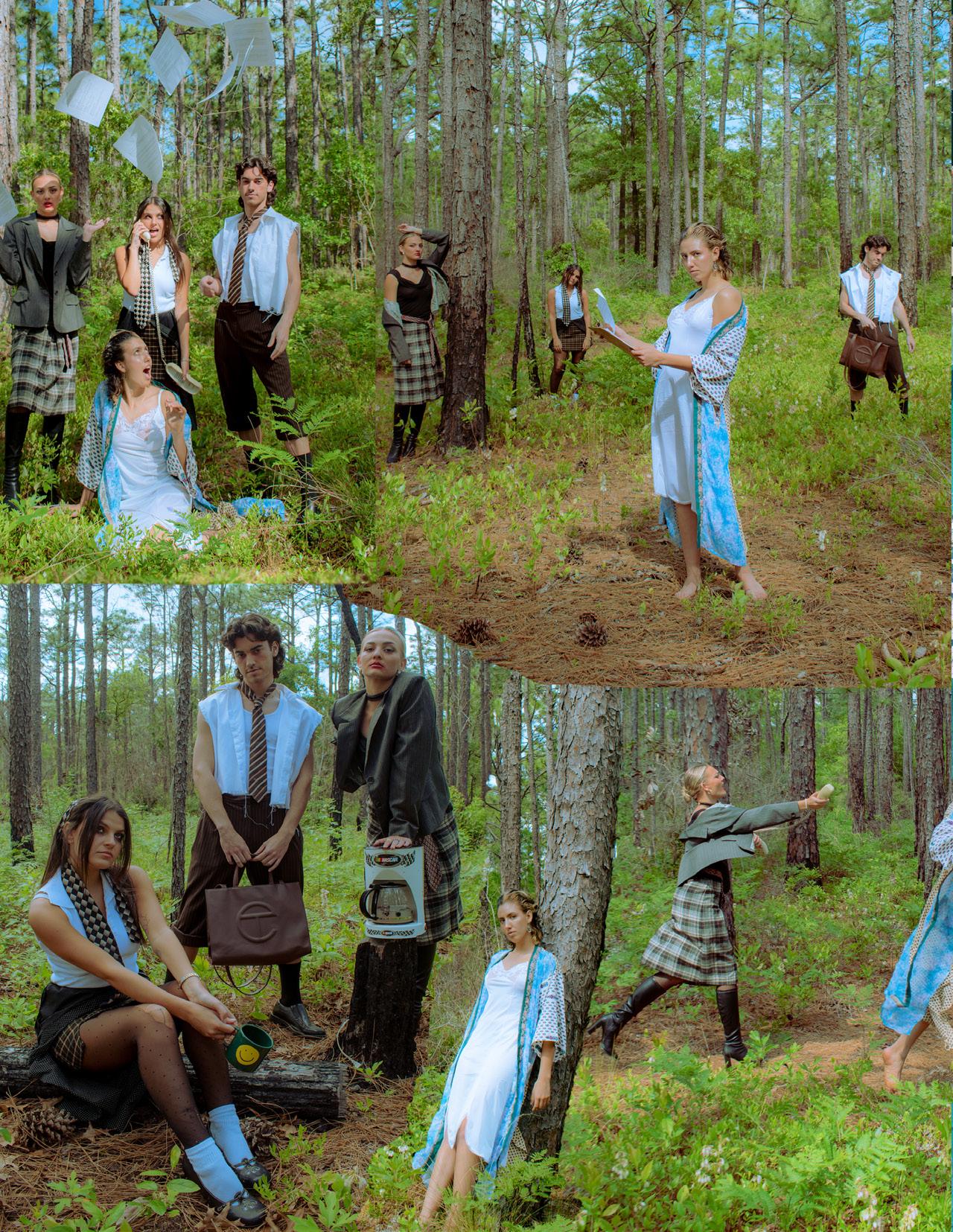
32 | Flair Magazine
I confess I didn’t dream of labor, or at least not working in an office, but that’s maybe where I’ll end up.
My life gets rearranged like water. I swim through joys so different from the ones I dreamed of and despairs I never dreamed I’d face.
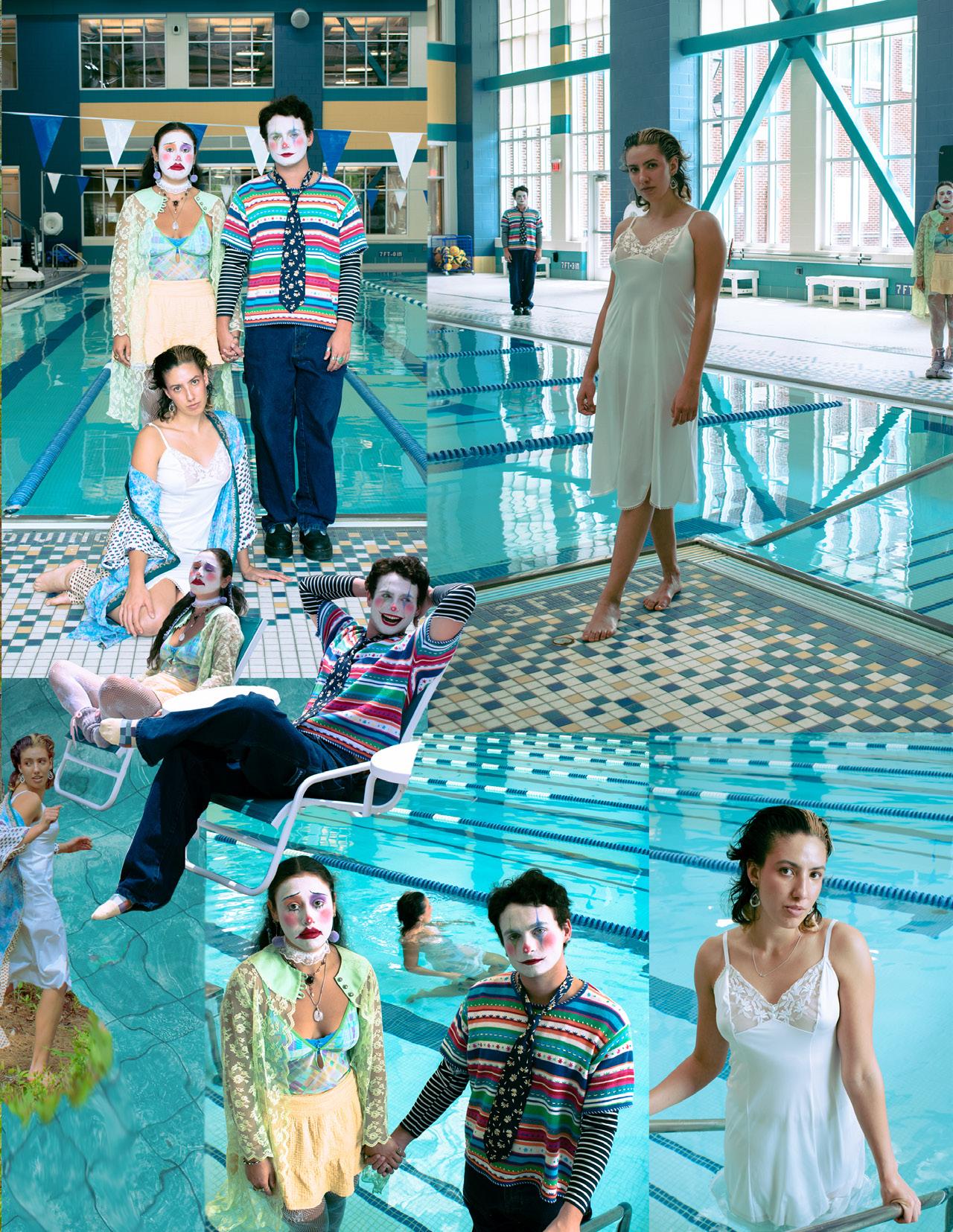
Flair Magazine | 33

34 | Flair Magazine

Flair Magazine | 35
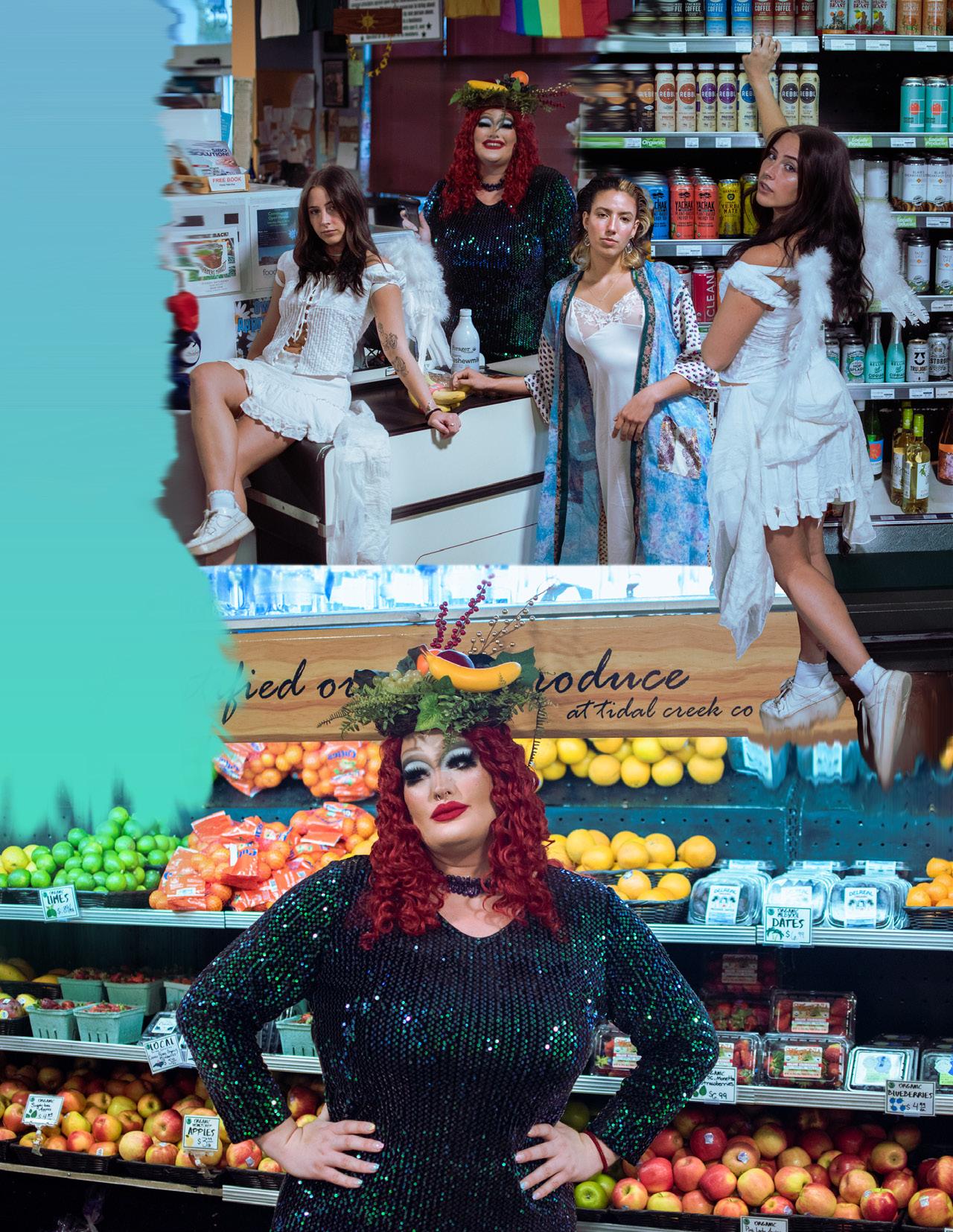
36 | Flair Magazine
I meet the most significant people in everyday places, places I didn’t think I would belong in. You really changed my life.
And when the dream ends, I wake up alone. I was born from my mother but I know from here on it’s up to me: to find my own comforts, create my own stability. I’m scared the only dream I have now is to love and be loved in return.

I’ll find new ones, I always do.
- Rian
Flair Magazine | 37
Headfirst Into Icy Waters
 Written by: Brooke Zarzycki
Designed by: Taylor Puckett
Written by: Brooke Zarzycki
Designed by: Taylor Puckett
Over the colder months this past semester, when most steer clear of the chilly waters of Wrightsville beach, me and my friends dove headfirst into the water any chance we could get. Aside from the laughs, shrieks, and time spent together that this quick activity brought us, there are valuable mental and physical benefits to this concept of a cold plunge. When the water is cold, the sky is gray, and the windchill is even colder, jumping into the water, or submerging yourself into an ice bath, can seem like a daunting activity. Why make ourselves so uncomfortable for a couple minutes when we can stay dry and cozy inside? I had this similar thought process when I was first invited to join friends for their daily plunge, even turning down the invite once or twice before finally deciding I had to do it to at least keep my pride. The funny thing is, once I finally did it, I instantly understood the draw. After that initial cold plunge, I pushed myself to try and plunge every day that I could, no matter the weather outside or the time of day. It slowly made its way through my friends and within a couple weeks I always had a crew by my side to plunge with. I started to research into the benefits, looking at the Wim Hof method and other medical articles on the subject, and the way these plunges left me feeling truly resonated with what I would read online. It was addicting, and I’ll tell you why. Nothing jolts you into the present more than the shock of icy water taking your breath away, like seriously it sometimes felt like a punch square into the gut, and a small fire burning in your chest. Enticing, I know. But slowly, your breath finds rhythm, your muscles relax, and your mind clears. The ability to overcome a harsh and uncomfortable environment does not disappear as you exit the water. Cold water immersion is an invaluable method of mental strength and clarity. It brings you back to yourself, focusing on what your body is feeling rather than what’s running around your mind. This practice of resilience and determination trained me to be able to handle stress and uncomfortable situations with more ease. Experts express its ability to reduce stress and anxiety through improving sleep and releasing dopamine and endorphins. I can truly say that after consistently practicing cold water immersion, even if just for two or three minutes at a time, I left feeling energized and ready to tackle whatever I had ahead of me. I began to look forward to my plunges and felt a sense of pride and confidence upon completing them. Not only are you serving your mental health, but you are facilitating healing within your body. Cold water can help with your lymphatic system and circulation, reducing inflammation, boosting metabolism, and aiding in skin, hair, and nail health. Not only are the benefits plentiful, but this practice is a free and accessible method to care for the well-being of your mind and body. If you are still questioning whether the benefits are worth the initial discomfort, I urge you to do your research and try for yourself! Start small and try turning your shower to cold water for a couple minutes at a time, see how this feels. If you conquer that, try jumping into a cold body of water if one is accessible. During the winter months here, we are lucky to have the ocean and free parking, so bring some friends and make an event out of it. Lastly, try filling a bath with ice water, and submerge yourself for a short period of time. The more routine you are with it, the easier it gets. Most importantly, listen to your body! If you are shivering, it might be time to end that plunge. If you choose to give cold plunging a try, keep track of how it makes you feel mentally and physically, and you just might find it serves you in the same way it has served me! Happy plunging!
DEEP BLUE SEA
Art Lown

WHO LOVES THE SUN
The Velvet Underground A WORLD SO FULL OF LOVE
Shakey Graves
SOMETHING NEW
Babe Rainbow
SUGAR
Stevie Wonder
KEEP THOSE TEARDROPS FROM FALLING
Natalie Bergman
AINT NOTHING LIKE THE REAL THING
Marvin Gaye, Tammi Terrell
I TRIED TO TELL MYSELF
Al Green
SILVER SPRINGS
Fleetwood Mac
LOVE IS STRANGE
Buddy Holly
DIRTY WORK
Steely Dan
HYPOTHETICALS
Lake Street Dive
Curatedanddesignedby GraceBaeurle
SUMMER SONG SUGGESTIONS
Flair Magazine | 39
 PhotogrAphy & Design by: LAuryl Meile
CreAtive Director: MAx StAfford
PhotogrAphy & Design by: LAuryl Meile
CreAtive Director: MAx StAfford
40 | Flair Magazine
Models: Neke Turko, CAmeron Hegarty, BrAyleigh Jones, Brooke ZArzycki, TAlulA Dechev

Flair Magazine | 41

42 | Flair Magazine

Flair Magazine | 43

44 | Flair Magazine

Can We Separate The Art From The Artist?

J.K. Rowling. Michael Jackson. R. Kelly. Woody Allen. Pablo Picasso. Charles Dickens. These are some names that might come to mind when we consider whether or not we can separate the art from the artist. This debate has intensified following Kanye West’s anti-Semitic remarks on social media, leaving fans conflicted as to whether or not they can express their displeasure with the artist without giving up his music. Coming to terms with this moral dilemma demands some honest, moral interrogation.
I used to have a set opinion on this debate, arguing that we cannot separate the art from the artist. To me, it sounded like a cop-out: a way to disassociate from the monstrosities of an artist. Ignorance is bliss, right? However, the more I dive into this issue, the more I realize it isn’t so black and white.
Saying that we cannot separate the art and the artist means acknowledging that making art is an intimate experience. Artists draw from their own experiences and worldviews to create something unique. Separating the two assumes that art doesn’t have a source, meaning, or influence. After all, we wouldn’t separate art from an artist we love and agree with. I love Taylor Swift’s music, therefore, I love her, and visa-versa.
I assume that, for the most part, our struggle to separate the art and the artist is monetary. By consuming a problematic artist’s art, we indirectly contribute to
written by Sammie Muller designed by Rian Lounsbury
their financial success. Some of us might personally boycott these artists by refusing to consume their content, which is fine. I never really liked Kanye’s music that much, anyway. However, like most of us, I am a huge Potter-Head. Reading and watching Harry Potter was a huge part of my childhood and has influenced my creativity today.
Removing ourselves entirely from the world of Hogwarts is difficult, but the expectation to do so can be reductive and outright patronizing. It isn’t rational for us to love a text for decades to then retrospectively un-love it. One way to ease this cognitive dissonance is to ask ourselves, what does the art ask of us? Does the context of the art have any relation to the controversy of the artist? Does the artist ask us to subscribe to their problematic views?
While some could argue that some of Harry Potter’s subtexts have traces of J.K. Rowling’s antisemitic and transphobic rhetoric, I don’t believe Harry Potter shows concrete evidence of the artist’s immorality. By loving Harry Potter, it is my opinion that you are not subscribing to Rowling’s beliefs. Fan-based communities, such as mugglenet.com, still celebrate the content of the narratives while denouncing J.K. Rowling as an author. Many college quidditch teams have even changed their names to disassociate with the franchise while still enjoying the game.
46 | Flair Magazine
On the contrary, there can be some damning evidence in art that reveals the horrors of an artist. For example, in 1993, R. Kelly wrote singer Aaliyah’s debut album, “Age Ain’t Nothin’ but a Number.” The next year, 27-year-old Kelly married Aaliyah, who was only 15, and demanded her secrecy. Knowing R. Kelly’s history, many of his lyrics are truly skin-crawling. In this case, is prioritizing Kelly’s music more important than the many women he harmed? In all cases, we must ask ourselves if our love for an artist’s work is greater than the weight of their misconduct.
There are some cases where the artist isn’t as easily identifiable. I don’t think there is a moral person on earth who would condone what Harvey Weinstein did, for example. However, he does not stand alone as the sole artist for his films. To boycott his films could discredit the huge crew that also contributed, such as the producers, actors, set designers, and even runners.
Arguing that you cannot separate the art and the artist is not the same as saying someone is problematic for consuming their content. Our individual relationships with art are, frankly, no one’s business. However, we should be able to answer why we like a particular work of art regardless of the artist’s history. If we do not know, then perhaps we are simply ignoring who the person is and thus ignoring the things they have said and done. Enjoying art made by problematic artists may require an additional layer of critical thinking.
On the flip side, there are some reasons why we can (and I believe we should) separate the art from the artist. It is true; there are instances where separation is a cop-out; some people tend to make excuses for those who do abhorrent things to give themselves peace of mind, all while blaming “wokeness” and “cancel culture” on an artist’s downfall.
However, there are also instances where separation truly allows us to condemn and denounce the artists without feeling the need to soften the blow of their actions. By completely alienating the problematic artist from their art by giving the art subjective meaning, we remove the power of interpretation from the artist’s hands.
Finally, without separating the art from the artist, the future of censorship may remain unclear. Is there a line that can be drawn based on how bad a person is? Our society is built upon patriarchal, racist, homophobic, and antisemitic ideologies. Omitting things like the Bible, philosophy, ancient Greek work, and certain works of art may seem like the morally correct thing to do, but it also doesn’t leave us with a whole lot. Are there things that should simply not be accessed because of an artist’s monstrosity? I would argue no, as removing art not only threatens our freedom of speech, but our freedom to interpret things in a critical manner.
 illustrated by Laura Isabel
illustrated by Laura Isabel




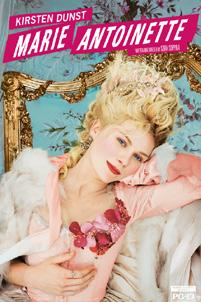

what movie you should watch
on your zodiac sign FIGHT CLUB ARIES March 21 - April 19 MARIE ANTOINETTE TAURUS April 20 - May 20 FREAKY FRIDAY GEMINI May 21 - June 20 LADY BIRD CANCER June 21 - July 22 PEARL LEO July 23 - August 22 ALIEN VIRGO August 23September 22 48 | Flair Magazine
based
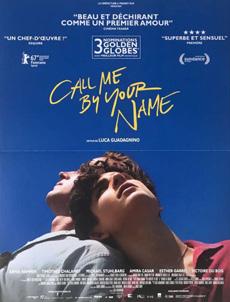
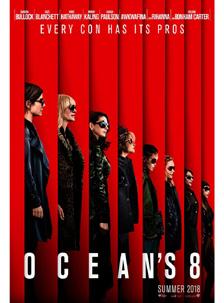




ME BY YOUR NAME LIBRA September 23October 22 VENOM SCORPIO October 23November 21 INTERSTELLAR SAGITTARIUS November 22December 21 OCEANS 8 CAPRICORN December 22January 19 ETERNAL SUNSHINE OF THE SPOTLESS MIND AQUARIUS January 20February 18 LA LA LAND PISCES February 19March 20 Flair Magazine | 49
Curated & Designed by Taylor Puckett CALL
Glad Rags Glad Rags
Photographer: Jaelin Hilliard
Creative Director: Jaelin Hilliard
Models: Dinadja Davis, John Dinkins, Kylie Owen
Makeup: Grayson Vick, Rae Goergen
Styling: Jaelin Hilliard, Max Stafford, Lauryl Meile, Rian Lounsbury

Lighting Design: Ashna Patil
Props: Art & Design Committee
Photography Assistant: Lauryl Meile
Designer: Jaelin Hilliard
50 | Flair Magazine
Glad Rags is 1920s slang for your best clothes, or most showy clothing. This photoshoot was inspired by 1920s fashion & the silent film aesthetic, mixed with indie sleaze fashion from the early 2010s.



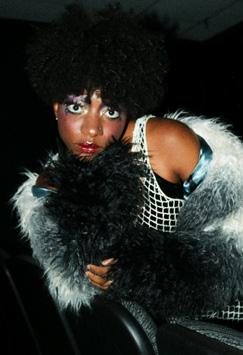










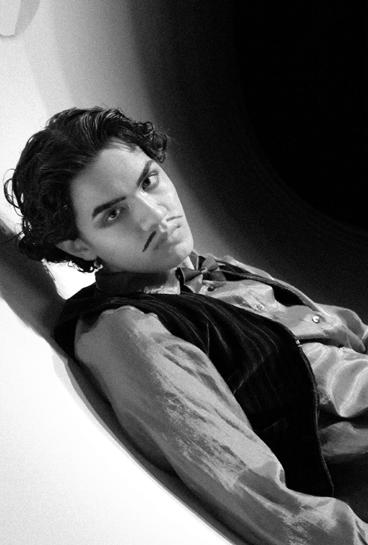


52 | Flair Magazine








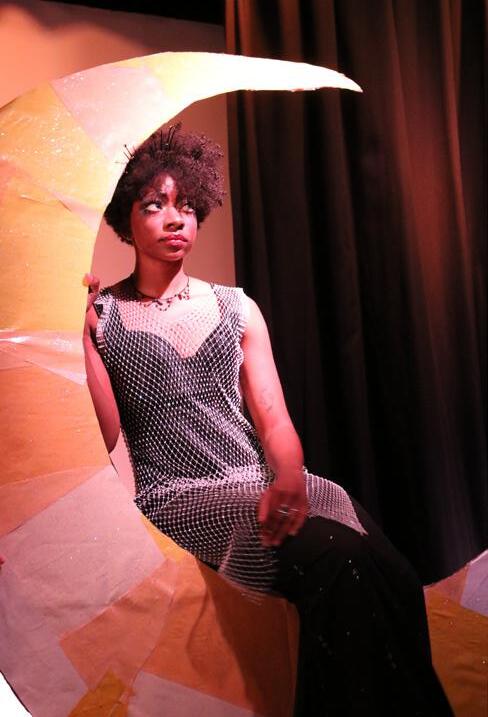

54 | Flair Magazine





Flair Magazine | 55
Positive Masculinity
Written and Designed by Sara Berry
Written and Designed by Sara Berry
The tendency to describe masculinity as aggressive and damaging, is reductive and dangerous Traditionally, masculinity includes the glorification of traits such as power, strength, and masculinity, which are not innately “bad.” A lack of respect can indicate a lack of power in this warped perspective, and society has ingrained these desires so deeply in boys, they may attempt to achieve said traits through unjust ways such as crime and violence against others.
Being stuck in traditional masculinity:
What does traditional masculinity look like?
* Believing that vulnerability in any capacity reduce their masculinity
like?
* Male displays of emotions are constrict ed to the “acceptable” options such as aggression, jealousy, lust, etc
* Emotional denial, suppression, or disconnection
* The idea that men never say no to sex and should conquer as many sexual partners as possible
What is positive masculinity?
Rather than focusing on the ways in which masculinity can be dysfunctional, damaging or dangerous, this approach looks for the best in men, focusing on the potential for men to lead happier, healthier, more fulfilling and better connected lives. It can manifest in very dif ferent ways for every person. But a general description I like is: coming the societal pressures and stereotypes that say certain values and emo tions are ‘masculine’ or ‘feminine’ in positive outcomes regarding health and wellbeing. This includes fostering a sense of duty towards others, and recognising the positives that can come from looking out for others.
Men are less likely to seek mental health services or engage in preventive health care. Their empathic abilities are reduced and men are less able to recognize when others need help. Pressure being put on relationships due to issues with communication, unequal sharing of household chores, and/or all emotional labor being put on the other partner. Isolating behaviors, greater rates of male suicide and risk taking behaviors. We are all put at greater risk from male violence and abuse.
MOST men don’t personally agree with “real men’’ stereotypes. Unfortunately, many go along with the expected attitudes and behaviors because they think most of their peers endorse them, and it is much easier to subscribe to common culture than loudly push against it.
Everyone can support positive masculinity:
1. Communicate: Ask for help, encourage vulnerable conversations about it

2. Recognize the alternative measures of male achievement beyond power, financial success, and physical attributes such as remaining optimistic in the face of adversity, setting personal boundaries, and improving your mental health. . Address the disrespect: Calling out other men who engage in behaviors that are aggressive and disrespectful. Refraining from sexist jokes and being an active bystander.
Practice healthy relationship skills: active listening, communication, nonjudgmental support, seeking out consent.
5. Encourage men to demonstrate nurturing, compassion, and caring behavior toward themselves and others
6. Check in with your friends and loved ones.
56 | Flair Magazine
The Right to Bleed
Written by Anna Williams
Designed
I can remember being told in middle school that if I ever needed a tampon from the nurse, I could ask for a “Starburst” so that I didn’t have to feel shameful or embarrassed to admit that I was on my period. From the very beginning, I was inadvertently taught that having a period was something to be talked about in code rather than blatantly. Girls quickly became skillful in the act of slyly slipping a tampon or pad up their shirt sleeve on the way to the bathroom so that no one would see.

The stigma around menstruation is one that has existed throughout history and across cultures. It tells women that menstruating is a fault of their biology; that bleeding makes them unclean, impure, weak. In other parts of the world, a girl’s first period is the gateway to a variety of violations like forced marriage, the end of their education, restrictive rules, or unwanted teen pregnancy. There are cultures that forbid a woman from entering a man’s house if she is menstruating, and cultures that force women to stay at home until her cycle is over. Many girls are not properly prepared for their period before it happens; some don’t even know what it is and are understandably scared when they see blood appear between their legs. Teachers and doctors should be held accountable for their lack of educating children on the natural processes of the body. Many women fall victim to the stigma themselves. For example, it is common for mothers to avoid discussing periods with their daughters. This oversight leads to misinformation and lack of education. Not only should mothers, teach- ers, and doctors ensure that young girls are pre- pared and knowledgeable about their bodies, but boys as well. The amount of men that are clueless when it comes to menstruation is astounding. And as with anything else, people are afraid of what they don’t understand. This lack of education fuels the myths surrounding periods that are used to humiliate and ostracize women.
There are many groups that are left out of the menstrual health conversation. The trans community, homeless women, nonbinary people, and women in prison are often overlooked when it comes to menstrual health. It is important to include these marginalized groups when dismantling the stigma around periods because they are often the most impacted. Access to menstrual resources is difficult for a lot of people with periods, but even more so for those who are not often thought of as in need of such resources.
Menstrual health is a human right. The way to tackle the stigma surrounding periods is to treat them as such. Policy change is necessary to make menstruation products more accessible to women and people who have periods around the world. There are many grassroot organizations, feminist activists, and human rights activists who are fighting for this change. One of those activists is Vannessa Zammar, founder of a feminist collective that provides menstrual education, products, and a safe space for women to share their experiences in Lebanon called Jeyetna. Her idea of making positive change in menstrual health is to “prioritize the voices, demands, priorities, needs and choices of women, girls and people who menstruate themselves, for they are the experts of their own contexts and experiences’’ (United Nations). Once we start thinking about menstruation as a human right, the topic that was once so taboo will become a prioritized point of activism.
“Removing the Shame and Stigma from Menstruation.” OHCHR, United Nations Human Rights , 8 July 2022, https://www.ohchr.org/en/stories/2022/07/removing-shame-and-stigma-menstruation.
by Taylor Puckett Flair Magazine |
57


Flair Magazine | 59

60 | Flair Magazine
Special Thanks to: ThE PlaCE & RIDGEWOoD DOGGY DaYCaRE La VETa PaSs WINsTON ORZ for an exCelLlLlenT release parTY charitY show in supPorT of mother hubbarD’s cupboarD motherhubbarDsNc.com 615 S 15th StReEt, WilminGton, Nc unCw’s StudenT RecReatiOn CenTer LeOnarD aquaticS FacilitY aNd to: Tidal CreEk Co-op 5329 OleanDer Dr #100, WilminGton, Nc For the use of theIr facilitiEs as photoshoOt locatiOnS in this isSuE LOVE Ya GUYS! & desiGNed bY rian loUnSburY i ] i k
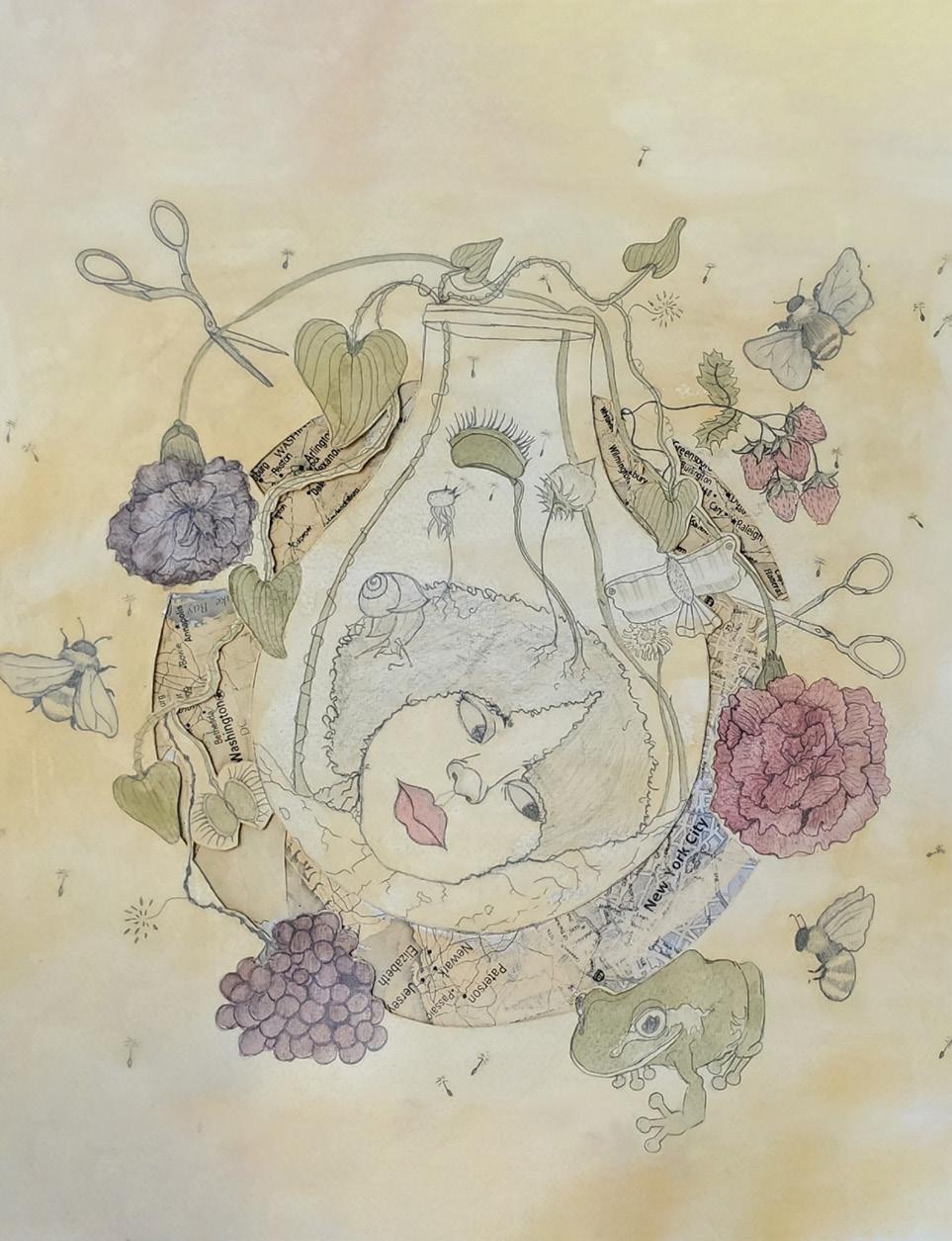 Cover Photographer Taylor Puckett
Model Erika Gonzalez
Artwork Dinadja Davis
Cover Photographer Taylor Puckett
Model Erika Gonzalez
Artwork Dinadja Davis









 Sara Berry Director of Fundraising and Marketing
Baylee Smeeton Social Media Chair
Rian Lounsbury Director of Art and Design
Marilyn Bolderman Associate Editor
Anna Williams
Fashion and Beauty Editor Brooke Zarzycki Lifestyle Editor
Taylor Puckett Editor in Chief
Anna Williams
Fashion and Beauty Editor
Marilyn Bolderman Associate Editor
Brooke Zarzycki Lifestyle Editor
Rian Lounsbury Director of Art and Design
Baylee Smeeton
Social Media Chair
Sara Berry Director of Fundraising and Marketing
Taylor Puckett Editor in Chief
Sara Berry Director of Fundraising and Marketing
Baylee Smeeton Social Media Chair
Rian Lounsbury Director of Art and Design
Marilyn Bolderman Associate Editor
Anna Williams
Fashion and Beauty Editor Brooke Zarzycki Lifestyle Editor
Taylor Puckett Editor in Chief
Anna Williams
Fashion and Beauty Editor
Marilyn Bolderman Associate Editor
Brooke Zarzycki Lifestyle Editor
Rian Lounsbury Director of Art and Design
Baylee Smeeton
Social Media Chair
Sara Berry Director of Fundraising and Marketing
Taylor Puckett Editor in Chief









 Written by Sophia Reese
Designed by Rian Lounsbury
Written by Sophia Reese
Designed by Rian Lounsbury


















































 Written By: Rian Lounsbury Designed By: Lexie Huck
Written By: Rian Lounsbury Designed By: Lexie Huck


 Illustrated by Laura Isabel
Illustrated by Laura Isabel









 Written by: Brooke Zarzycki
Designed by: Taylor Puckett
Written by: Brooke Zarzycki
Designed by: Taylor Puckett

 PhotogrAphy & Design by: LAuryl Meile
CreAtive Director: MAx StAfford
PhotogrAphy & Design by: LAuryl Meile
CreAtive Director: MAx StAfford






 illustrated by Laura Isabel
illustrated by Laura Isabel

















































 Cover Photographer Taylor Puckett
Model Erika Gonzalez
Artwork Dinadja Davis
Cover Photographer Taylor Puckett
Model Erika Gonzalez
Artwork Dinadja Davis